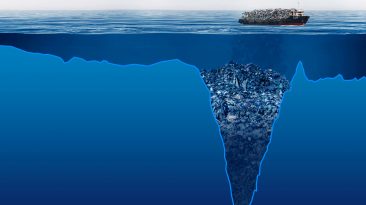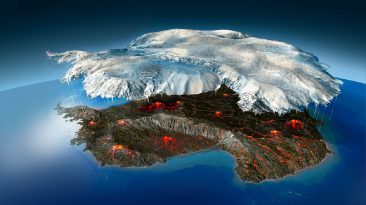The captain sounds the alarm. The waters around the ship rumble. Strange lights from deep below inch closer and closer to you. Something is emerging from the Mariana Trench, and it does not belong on this planet. If aliens lived in the deepest place in the ocean, what would they look like? How would they communicate with each other? And what would happen if we dared to contact them?
There’s a reason why the idea of aliens living at the bottom of the sea keeps popping up in popular culture. Many of us are far more afraid of what lies down there than whatever is looking at us from up in space. After all, 80% of the ocean is still unmapped and unexplored. We have better maps of the Moon, Mars and Venus than we do of our seafloor.
The most mysterious part of our oceans is the Mariana Trench. Its deepest point, the Challenger Deep, stretches 11 km (7 mi) down. The Mariana Trench is anything but a great vacation spot. No light is able to reach its bottom, and temperatures are just a few degrees above freezing. Not to mention its crushingly high water pressure. So how could aliens survive at the deepest spot in the ocean?
The water pressure at the bottom of the Mariana Trench is over 1,000 times the atmospheric pressure that you’re used to at sea level. This kind of pressure would crush anything, even the toughest deep-sea robots we’ve ever built. But some living things managed to adapt and thrive under such pressing conditions. Like translucent snailfish and sea cucumbers.
The hadal snailfish, known as the deepest living fish, flourishes at depths of over 8 km (5 mi). Unlike you, deep-sea fish don’t have pockets to store air in their bodies. That oxygen inside your lungs is what gives you the feeling of pressure whenever you take a dive. No air means this fish has a higher tolerance to the weight of all that water above it.
Whatever aliens were lurking down below would also share the same characteristic. Storing air just wouldn’t be their thing. But what would they do for food? Well, it’s likely, they’d imitate their seafloor neighbors once again. Deep-sea creatures gorge on the decaying remains of microbes, algae or animals from above. Our sunken ships might be their version of a surprise buffet.
Any extraterrestrial life down at the pit of the trench would probably eat similar food. They’d burrow into the biggest carcasses they could find and consume what’s left from the inside out, like a giant hagfish does. Or, they might possess enormous mouths and expandable stomachs, allowing them to catch and digest large quantities of food as they move.
And those big mouths of theirs would also be filled with long fangs pointed inward. This would enable them to catch and hold on to other deep-sea creatures or, you know, any prey that just so happens to dive a little too far from the surface. Hey, don’t judge them. In a habitat as precarious as the Mariana Trench, aliens would need to capitalize on any and all sources of nutrition.
They’d also have to go the extra mile in order to let one another know they’re out there in the pitch dark. That’s because sunlight can only travel up to 1 km (0.6 mi) into the ocean. Anywhere deeper than that and you wouldn’t be able to see a thing. So how would our underwater aliens put the notice out they’re around? Two ideas. By sound and by light they produce themselves.
Like fireflies, deep-sea creatures are able to produce and emit their own light thanks to a process called bioluminescence. With it, aliens would be able to connect with each other through specific lighting patterns. For long-distance communication, they could send out sound waves across enormous distances in the water. Like the humpback whale, who’s able to sing in the Caribbean and be heard off the west coast of Ireland 6,400 km (4,000 mi) away.
Now, what would first contact with this underwater species look like for us? Well, we’d have to get there first. We’d need a vessel strong enough to withstand the constantly intensifying pressure. The tiniest of cracks would squash you and your submarine faster than you can say “human jam”. Once there, we’d have to take into account that living at the bottom of the sea would be like living on another planet.
If aliens existed in the other-worldly depths of the Mariana Trench this entire time, they might not want to be friendly neighbors. And the darkness alone would make it difficult to locate and study our subjects. Before approaching these extraterrestrials, we’d have to assess their communication style first, slowly and patiently. We’d need to understand how they interact with their environment too. That is assuming they don’t feel threatened by our presence and decide to do something about it.
Sources
- “How Much Of The Ocean Have We Explored?”. 2022. oceanservice.noaa.gov.
- “Mapping The Oceans”. Jess I. T. Hillman. 2022. kids.frontiersin.org.
- “Mariana Trench: The Deepest Depths”. Becky Oskin. 2022. livescience.com.
- “Nereus Soars to the Ocean’s Deepest Trench”. Amy Nevala, Lonny Lippsett. 2009. whoi.edu.
- “The Science Of Aliens, Part 5: How Would They Communicate?”. Dirk Schulze-Makuch. 2021. smithsonianmag.com.



























